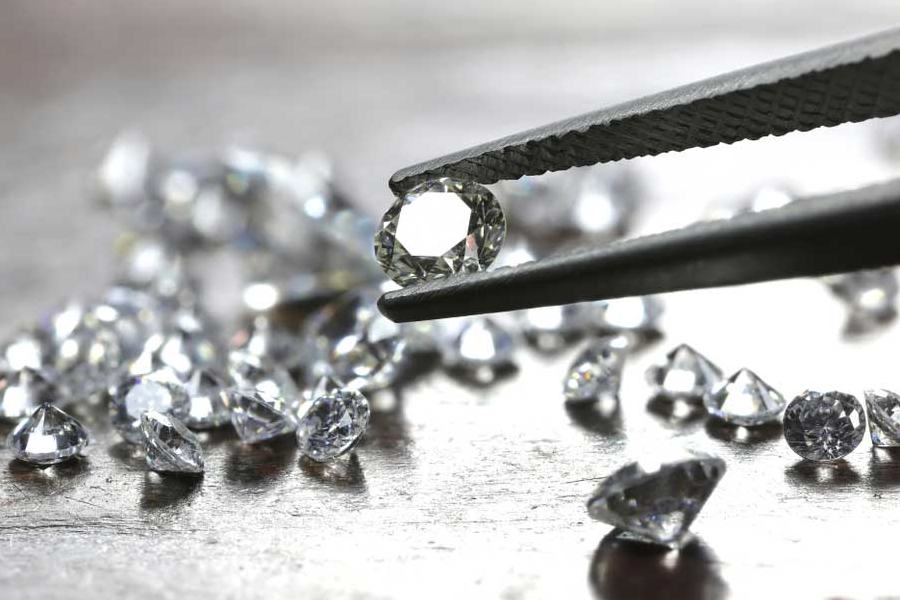India's diamond sector is facing a severe crisis as both imports and exports have sharply declined in the past three years, which has triggered defaults, factory closures, and widespread job losses, think tank GTRI said on Wednesday.
It said that while export returns have surged, a large inventory of unprocessed rough diamonds is piling up due to reduced orders and growing competition from lab-grown diamonds.
"This has triggered defaults, factory closures, and widespread job losses. Tragically, more than 60 people in Gujarat's diamond sector have committed suicide, reflecting the severe financial and emotional strain India's diamond sector is facing," Global Trade Research Initiative (GTRI) Founder Ajay Srivastava said.
He said that immediate action is essential to address these problems and safeguard the future of the sector.
According to the think tank data, a 24.5 per cent drop in rough diamond imports from USD 18.5 billion in 2021-22 to USD 14 billion in 2023-024 shows weaker global markets and fewer processing orders.
After adjusting for re-exported rough diamonds, net imports declined by 25.3 per cent, from USD 17.5 billion to USD 13.1 billion, indicating reduced demand for processing in India.
Exports of cut and polished diamonds fell by a higher margin of 34.6 per cent, from USD 24.4 billion in FY 2022 to USD 13.1 billion in FY 2024, it said.
"Additionally, the share of unsold diamonds returned to India increased from 35 per cent to 45.6 per cent during this period," it said adding the net exports of cut and polished diamonds dropped by 45.3 per cent, from USD 15.9 billion to USD 8.7 billion, reflecting a weak market and rising unsold inventory.
The gap between net rough diamond imports and net cut and polished diamond exports widened significantly, from USD 1.6 billion in FY 2022 to USD 4.4 billion in FY2024, signalling a large inventory buildup and a lack of sufficient export orders.
It added that some challenges of the sector stem from regulatory issues and internal inefficiencies within the industry.
It said the demand for polished diamonds has dropped sharply in key markets like the US, China, and Europe due to economic uncertainty, inflation, and geopolitical tensions, leading to reduced consumer spending on luxury goods, including diamonds.
"Fluctuations in global diamond prices have caused uncertainty, with buyers hesitant to purchase rough diamonds in anticipation of further price drops," Srivastava said.
He added that the Russia-Ukraine conflict has also disrupted the global diamond supply chain, with sanctions on Russia, a major rough diamond producer, further complicating trade and slowing down the global diamond trade.
Shifting consumer preferences toward lab-grown diamonds, which are more affordable, ethical, and sustainable, are also impacting the demand for natural diamonds.
On internal factors, the think tank said that many polishing units have large unsold inventories of polished diamonds, which discourages them from importing fresh rough diamonds as they cannot afford to take on more stock without selling their existing inventory.
"Rising operational costs, including labour, energy, and materials, along with reduced margins in the global diamond trade, have made it difficult for many polishing units to remain viable, leading to shop closures and layoffs, especially in Surat," he said.
The industry also heavily depends on financing, but tighter credit conditions and reduced lending from banks have made it difficult for companies to purchase rough diamonds, further stalling production, he said.
"Additionally, a significant portion of cut and polished diamonds exported from India are being returned due to quality issues, overstocking by buyers, mismatches in specifications, and price fluctuations. Handling these returns is costly and time-consuming due to complex customs procedures, putting further strain on exporters," he added.
GTRI also stated that Dubai does not produce diamonds, yet its share in India's import of rough diamonds is increasing steadily.
Dubai imports rough diamonds from Botswana, Angola, South Africa, Russia and re-exports these to India.
Belgium's share of India's rough diamond imports dropped from 37.9 per cent in FY 2020 to 17.6 per cent in FY 2024. Dubai's share increased from 36.3 per cent in FY 2020 to 60.8 per cent in FY 2024 and further to 64.5 per cent in April-June 2024.
It said that a major reason for higher share of Dubai is India's high corporate tax regime applicable on foreign suppliers of rough diamonds, and this forces them to re-export diamonds to Dubai and export from there to India.
"This has rendered India's Special Notified Zones (SNZs) in Mumbai and Surat largely ineffective," it added.
Further to support the sector, GTRI suggested host of steps including extending export credit terms, exempting foreign rough diamond sellers from corporate tax in India; regulating the lab-grown diamond industry; and reconsidering zero tariff import of cut and polished diamonds from Dubai under the India-UAE trade pact.
"The RBI could extend the export credit period for cut and polished diamond exporters from 6 to 12 months, as buyers now demand longer credit terms. India's strong forex reserves make this feasible," the think tank said.
The Indian diamond industry consists of over 7,000 companies involved in various activities such as cutting, polishing, and exporting diamonds.
Most of these companies are concentrated in Surat, Gujarat, and Mumbai, Maharashtra. The majority of these firms are SMEs, with many family-owned businesses dominating the sector.
The diamond industry in India provides direct employment to about 1.3 million workers. This includes those involved in the cutting, polishing, trading, and exporting of diamonds.
Surat alone accounts for nearly 8,00,000 workers, making it the world's largest hub for diamond cutting and polishing.
The industry also supports millions of indirect jobs in related sectors such as logistics, transport, retail, and diamond tool manufacturing.
Except for the headline, this story has not been edited by The Telegraph Online staff and has been published from a syndicated feed.











